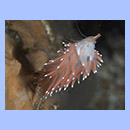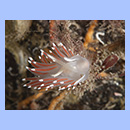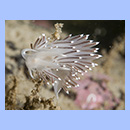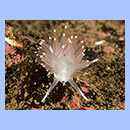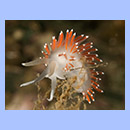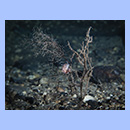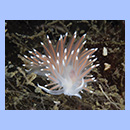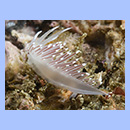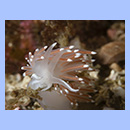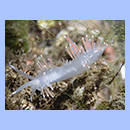- Kingdom: Animalia
- Phylum: Mollusca
- Class: Gastropoda
- Subclass: Heterobranchia
- Order: Nudibranchia
- Suborder: Dexiarchia
- Infraorder: Aeolidida
- Superfamily: Flabellinoidea
- Family: Coryphellidae
- Scientific name: Borealia nobilis
- Norwegian: -
Characteristics:
It has a semi-transparent, white body. Orange, red-brown or brown seem to be the most common cerata colors, but this cannot be used as identification as the cerata may take a wide range of colors. The rhinophores (tentacles on the head) have small warts. This feature can be used to distinguish it from the C. verrucosa. It can grow to a length of 4-5 cm. It easy to get confused when trying to identify the Flabellinoidea species:
- F. browni has smooth or slightly wrinkled rhinophores. The cerata are arranged in groups rather then rows. There is a white pigmented ring around the tip of the cerata. There is not a pink tint on the tentacles.
- M. gracilis does not exceed a length of 15 mm. The cerata is is usually arranged in two, but sometimes as many as five rows. The rhinophores are smooth.
- C. pellucida has red or orange, white tipped cerata. The rhinophores are wrinkled. There are white pigmentation on the tentacles.
- C. verrucosa has wrinkled rhinophores, usually with a white pigmented line. There may be a pink tint on the white-tipped cerata. Individuals with long cerata may be confused with many of the other Flabellina species.
Habitat:
It seems to thrive on rocky, current-exposed locations with a lots of hydroids to feed on.
Distribution:
This is an Arctic species, widespread in the North Atlantic Ocean, including Ireland and Norway.
